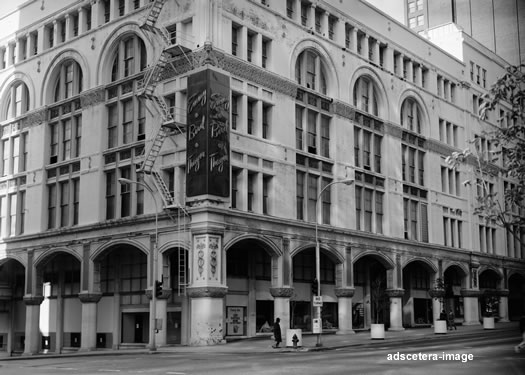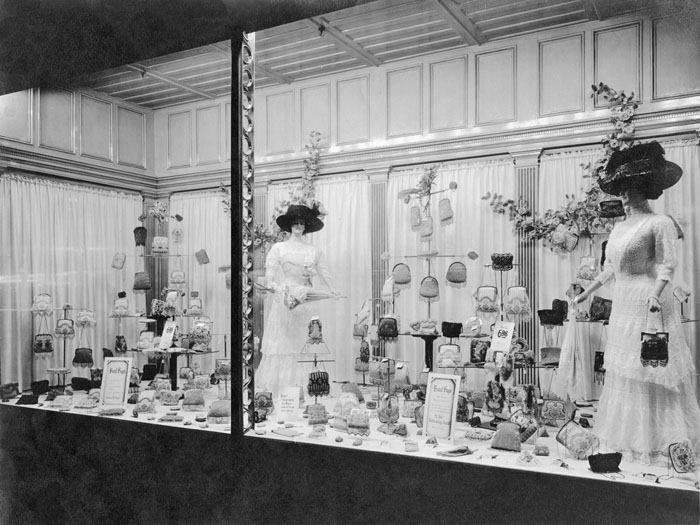
Emery, Bird, Thayer: A Kansas City Icon’s Grand Legacy
In the heart of Kansas City, where brick and limestone whispered tales of bygone eras, there once stood a beacon of elegance, a temple of commerce, and a cornerstone of community life: Emery, Bird, Thayer. More than just a department store, EBT, as it was affectionately known, was an institution, a grand dame that witnessed and shaped the city’s transformation from a bustling frontier town to a modern metropolis. Its story is a microcosm of American urban development, retail evolution, and the enduring power of a place to hold a city’s memories.
The Genesis of Grandeur: A Strategic Union
The roots of Emery, Bird, Thayer stretch back to the late 19th century, a period of explosive growth and burgeoning prosperity for Kansas City. The city was rapidly establishing itself as a vital transportation hub, a gateway to the West, and a significant agricultural and industrial center. This economic dynamism created fertile ground for ambitious merchants.
The story truly begins with the merger of two prominent dry goods establishments: Emery, Bird & Co. and Thayer & Bird. George Emery, a shrewd businessman, had already made a name for himself with Emery, Bird & Co., known for its quality goods and burgeoning clientele. William B. Thayer and Edwin C. Bird, partners in their own successful venture, shared a similar vision for upscale retail. In 1891, these titans of trade joined forces, giving birth to Emery, Bird, Thayer Dry Goods Company.
The consolidation was more than a simple amalgamation; it was a strategic union designed to dominate the burgeoning Kansas City market. The founders envisioned a store that would cater to the city’s growing middle and upper classes, offering not just merchandise but an experience. From its inception, EBT set itself apart with a commitment to quality, a wide array of goods, and, crucially, an unparalleled level of customer service. Early advertisements boasted of "the largest, most comprehensive stock of dry goods west of the Mississippi," a claim that, whether entirely accurate or not, certainly captured the ambition and scale of the new enterprise.
The Iconic Edifice: A Prairie School Masterpiece
While the initial store was located at 10th and Grand, it was the construction of their magnificent new building at 11th and Grand in 1909 that truly cemented Emery, Bird, Thayer’s place in Kansas City lore. This wasn’t just another commercial building; it was an architectural marvel, designed by the enigmatic and brilliant Louis Curtiss, often dubbed "the Frank Lloyd Wright of Kansas City."
Curtiss, known for his innovative use of steel-frame construction and his embrace of modern aesthetics, crafted a building that was both grand and functional, reflecting the burgeoning Prairie School influence. The ten-story structure, often considered one of the earliest "skyscrapers" in Kansas City, featured expansive window spaces, clean lines, and a monumental presence that commanded attention. Its innovative design allowed for maximum natural light within the store, creating an inviting and airy shopping environment. The building itself became a symbol of EBT’s modernity and its commitment to providing a world-class shopping experience.
Inside, the store was a labyrinth of wonders, meticulously designed to evoke luxury and ease. Ornate fixtures, polished wood, and gleaming display cases showcased everything from the latest Parisian fashions to exquisite home furnishings. The atmosphere was one of refined elegance, a stark contrast to the often chaotic and utilitarian nature of other retail establishments of the era. The building wasn’t just a container for goods; it was an integral part of the brand, an architectural statement that declared Emery, Bird, Thayer’s preeminence.
The Golden Age: A Department Store as a Cultural Hub
For much of the 20th century, particularly in the post-World War II boom years, Emery, Bird, Thayer was the undisputed crown jewel of downtown Kansas City retail. It was more than just a place to buy things; it was a destination, a social hub, and a significant part of the city’s cultural fabric.

Stepping into EBT was an event. The air hummed with genteel conversation, the rustle of fine fabrics, and the soft strains of live music from the Tea Room. This wasn’t quick-fix shopping; it was an immersive experience. The store boasted an astonishing array of departments, each a world unto itself:
- Fashion: From high-end couture to everyday wear, EBT was the arbiter of style for Kansas City. Fashion shows were a regular occurrence, drawing crowds eager to glimpse the latest trends. Bridal salons offered personalized service, making wedding dress selection a momentous occasion.
- Home Furnishings: Multiple floors were dedicated to furniture, rugs, and décor, showcasing beautifully arranged vignettes that inspired home makeovers.
- Specialty Departments: The store housed a vast book department, a well-stocked toy section that was a wonderland for children, and a comprehensive beauty salon.
- The Tea Room: Perhaps the most beloved feature, the Tea Room was an institution. It was the place for ladies to meet for lunch, for a mother and daughter to share a special outing, or for weary shoppers to recharge with a cup of tea and a pastry. It was a place of quiet refinement, offering a respite from the bustling city outside.
- Personalized Service: EBT prided itself on its attentive and knowledgeable staff. Sales associates knew their customers by name, remembered their preferences, and offered a level of personalized attention rarely seen today. This commitment to service fostered immense loyalty, making customers feel valued and understood.
During the holiday season, Emery, Bird, Thayer truly came alive. The elaborate window displays were a civic attraction, drawing families from across the metropolitan area to gaze in wonder at the festive scenes. Inside, Santa Claus held court, and the entire store transformed into a magical wonderland, brimming with holiday cheer. For generations of Kansas Citians, a trip downtown to see the EBT windows and visit Santa was a cherished annual tradition.
EBT faced competition, of course. Nearby, Harzfeld’s offered a more exclusive, boutique experience, while Woolf Brothers catered to the discerning gentleman. Kline’s and Macy’s (then a separate entity) also vied for shoppers’ dollars. But Emery, Bird, Thayer held its own, distinguishing itself through its vast selection, elegant atmosphere, and unwavering commitment to customer satisfaction. It was a place where generations of families shopped, where first communion dresses were bought, where engagement rings were chosen, and where memories were made.
The Winds of Change: Suburban Sprawl and Shifting Sands
However, even the most venerable institutions are not immune to the relentless march of progress and the changing tides of urban life. The mid-20th century brought significant societal shifts that would profoundly impact downtown retail.
The most significant factor was suburbanization. Following World War II, a booming economy and the proliferation of automobiles fueled a mass exodus from city centers to sprawling suburbs. With new homes came new shopping needs, and developers were quick to capitalize on this trend by building shopping malls. The opening of Ward Parkway Center in the early 1960s, followed by others like Blue Ridge Mall and eventually Oak Park Mall, presented a formidable challenge to downtown department stores. Shoppers no longer wanted to contend with city traffic, limited parking, and the perceived dangers of a decaying urban core. Malls offered convenience, ample parking, and a controlled, climate-controlled environment where shoppers could find everything under one roof.
Changing consumer habits also played a role. The formal, leisurely shopping experience that EBT excelled at began to feel outmoded. Consumers increasingly sought speed, efficiency, and a more casual atmosphere. The personalized service, once a hallmark, became a luxury that fewer people were willing to pay for, especially as discount retailers gained traction.
Downtown Kansas City itself began to suffer. Urban decay, white flight, and a lack of investment led to a decline in foot traffic and a perception of unsafety. The vibrant energy that once fueled places like Emery, Bird, Thayer started to wane.
Emery, Bird, Thayer did attempt to adapt. Recognizing the shift to the suburbs, they opened a branch store at the new Ward Parkway Center in the 1960s. This move, however, proved to be too little, too late. The suburban branch, while initially successful, couldn’t replicate the grandeur or the comprehensive selection of the flagship downtown store, nor could it stem the tide of declining sales at the original location.
The Final Curtain: A Painful Farewell
The inevitable arrived in 1968. After years of struggling against mounting losses and a dramatically altered retail landscape, the decision was made to close the iconic Emery, Bird, Thayer store at 11th and Grand. The announcement sent shockwaves through Kansas City. For many, it wasn’t just the closing of a store; it was the end of an era, a poignant symbol of the downtown’s decline and the changing face of American retail.
The closure of Emery, Bird, Thayer was a harbinger of things to come for many other downtown department stores across the country. Its fate mirrored that of countless other grand establishments that couldn’t survive the shift from urban centers to suburban malls. The Ward Parkway branch lingered for a short while longer, operating under a different name, but the heart of EBT, its soul, was forever tied to its magnificent downtown edifice.
A Lingering Legacy
Today, the grand building at 11th and Grand stands as a stoic reminder of Emery, Bird, Thayer’s enduring legacy. After its closure, the building underwent various transformations, housing different businesses and undergoing renovations to adapt to new uses. While its interior no longer buzzes with the vibrant energy of shoppers seeking the latest fashions or meeting for tea, its exterior remains a testament to Louis Curtiss’s architectural vision and the golden age of Kansas City retail.
Emery, Bird, Thayer was more than just a purveyor of goods; it was a cornerstone of community, a symbol of aspiration, and a repository of countless personal memories. It represented an era when shopping was an experience, a social ritual, and an integral part of civic life. Its story serves as a valuable lesson in the ebb and flow of urban development, the relentless evolution of commerce, and the enduring power of iconic places to shape the identity of a city. For those who remember its grandeur, Emery, Bird, Thayer remains etched in the collective memory of Kansas City, a cherished icon whose legacy continues to whisper tales of elegance and a bygone era.


